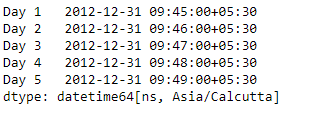Python|熊猫系列.dt.round
Series.dt可用于以 datetimelike 的形式访问系列的值并返回多个属性。 Pandas Series.dt.round()函数对数据进行舍入运算到指定的频率。
Syntax: Series.dt.round(*args, **kwargs)
Parameter :
freq : The frequency level to round the index to
Returns : DatetimeIndex, TimedeltaIndex, or Series
示例 #1:使用Series.dt.round()函数将给定系列对象的日期时间数据四舍五入到指定的频率。
# importing pandas as pd
import pandas as pd
# Creating the Series
sr = pd.Series(['2012-12-31 08:45', '2019-1-1 12:30', '2008-02-2 10:30',
'2010-1-1 09:25', '2019-12-31 00:00'])
# Creating the index
idx = ['Day 1', 'Day 2', 'Day 3', 'Day 4', 'Day 5']
# set the index
sr.index = idx
# Convert the underlying data to datetime
sr = pd.to_datetime(sr)
# Print the series
print(sr)
输出 :

现在我们将使用Series.dt.round()函数将给定系列对象中的日期时间值四舍五入为每日频率。
# round to daily frequency
result = sr.dt.round(freq = 'D')
# print the result
print(result)
输出 :

正如我们在输出中看到的, Series.dt.round()函数已成功地将给定系列对象中的日期时间值四舍五入到指定的频率。
示例 #2:使用Series.dt.round()函数将给定系列对象的日期时间数据四舍五入到指定的频率。
# importing pandas as pd
import pandas as pd
# Creating the Series
sr = pd.Series(pd.date_range('2012-12-31 09:45', periods = 5, freq = 'T',
tz = 'Asia / Calcutta'))
# Creating the index
idx = ['Day 1', 'Day 2', 'Day 3', 'Day 4', 'Day 5']
# set the index
sr.index = idx
# Print the series
print(sr)
输出 :

现在我们将使用Series.dt.round()函数将给定系列对象中的日期时间值四舍五入为每小时频率。
# round to hourly frequency
result = sr.dt.round(freq = 'H')
# print the result
print(result)
输出 :

正如我们在输出中看到的, Series.dt.round()函数已成功地将给定系列对象中的日期时间值四舍五入到指定的频率。